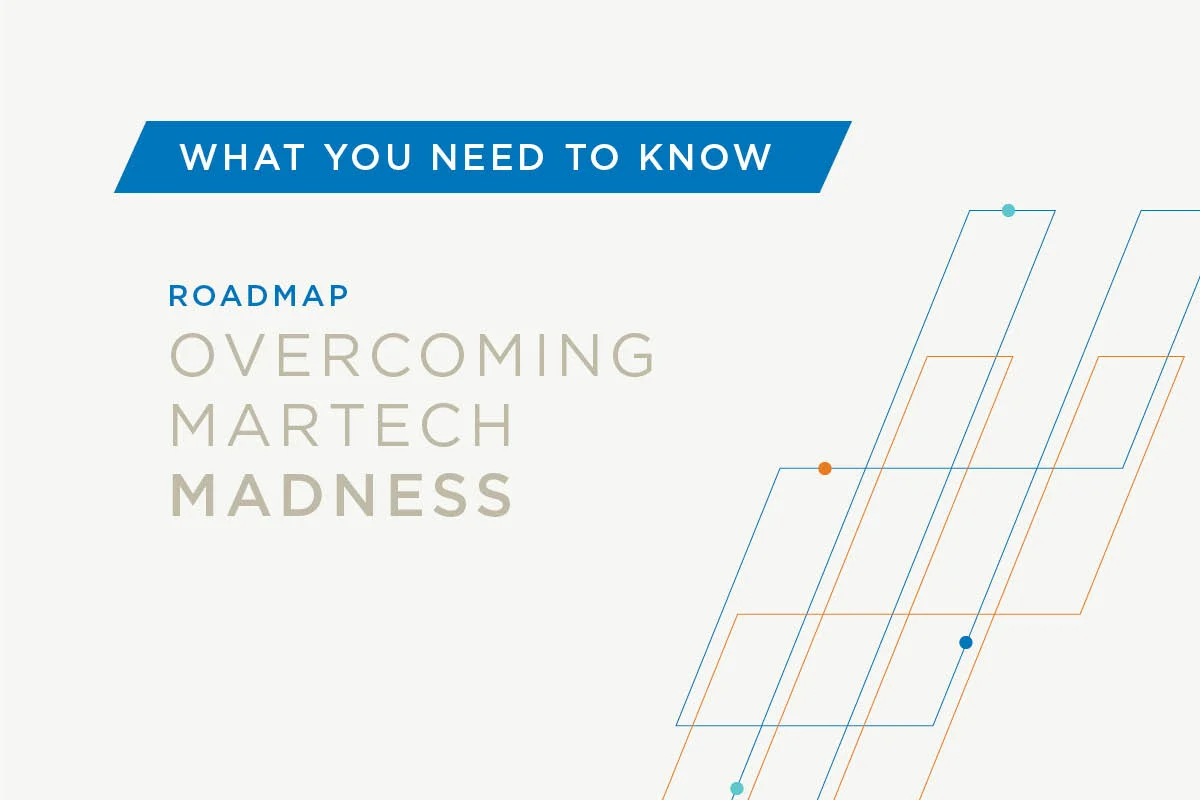If you have heard it once, you have heard it a thousand times.
DATA. PERSONALIZATION. AUTOMATION. EFFICIENCIES.
How many decades has the financial services industry been talking about leveraging our mountains of data to change the way we engage with the consumer?
Forty percent of legacy financial services organizations self-assessed their firms as being at the lowest maturity level in MarTech, compared to only 14 percent of technology firms.1 Banks self-scored the lowest, yet start-up banks have not been around nearly as long as traditional banks, don’t have the capital (at least initially), and most certainly don’t have the customer base and data assets like traditional banks.
Financial institutions must change this trajectory and rethink how they engage with customers. While it may start in marketing, it’ll take the entire organization’s buy-in to have transformational growth.
Analyze Data to Identify Marketing Opportunities
Banks and credit unions have an immense amount of opportunity if they can leverage their data assets and change the legacy mindsets that are holding them back. Buying another piece of technology that isn’t integrated across all systems, or moving to a new core system, is likely not going to yield the transformational results you are hoping to achieve. Marketing has a massive opportunity to lead their organizations by building better MarTech roadmaps to move their organization from product-centric to customer-centric. This is an exciting time for traditional bank marketers because they are being challenged at every corner. Edicts to do more with fewer resources. Rising interest rates will make it more difficult to acquire. Regulatory burdens will continue to impact them in ways they don’t know.
According to a recent Personetics survey, 51% of consumers surveyed wanted from their financial institution regarding how to best deal with inflation. Two-thirds of those who did hear from their bank were unhappy with the generic advice received.2
The Real Cost of Fees and Soaring Interest Rates
Vericast’s recent Financial Health Survey showed that 68% of people surveyed would consider switching to an organization that offers fewer fees and 66% of people surveyed felt similar about better interest rates.3 Consumers are looking for financial institutions to customize recommendations, like information on more affordable financial products or helping them remember to cancel a subscription they may have forgotten about.
Here are five key steps to building a more proactive relationship with your customers.
1. Build a MarTech Roadmap
As part of your strategic planning process, it is best practice to include a marketing tech stack gap analysis at least annually. What are vendors providing and where are the gaps that you aren’t able to deliver on because you don’t have the time, skills or technology? Aligning your marketing tech stack with your strategic initiatives and line of business objectives is critical. An easy way to start is to have your marketing vendors provide you with a 30-minute meeting to discuss their product roadmap and how they plan to support the financial services industry and your objectives. If you aren’t willing to invest 30 minutes with this vendor, it’s time to reconsider the business relationship.
2. Partner
Partner with your MarTech vendors through brainstorming sessions and get them to commit to how they can help you with your business objectives. Have your vendors deliver an annual pitch as if you were a new customer. This will help you stay up to date on any new features and ask questions about where they are headed. Provide your vendors with your strategic initiatives ahead of that meeting so they can tell you how they will support your business objectives.
3. Be Intentional
Running the business is the top reason organizations get stuck and can’t move forward. Are your MarTech vendors just doing what you tell them, or are they helping you move your business forward? Can you track how they are helping you increase revenue, profit, ROI or however you measure success? Quarterly business reviews keep you connected and engaged with your vendors. Ask which marketing technology is helping you in meaningful ways and question any vendor or technology that doesn’t make that list.
4. Extend Your R&D Budget
How often are you partnering with your marketing technology vendors to build quick wins or change how you approach the market through data intelligence? If you aren’t already, ask to be part of a beta program for products on the roadmap or vendor advisory committee/board. Leveraging your marketing technology vendors to extend your R&D budget is smart.
5. Never Settle
Ask “why” at least five times. I don’t know about you, but I’ve been in many meetings where I thought something sounded like a good idea, or that I understand what is being presented, only to find out later that I had a litany of questions after reflecting. See what happens when you ask why five times as you are actively engaged in listening to your vendors. One hundred percent of the time this will produce a better outcome for you.
Modernizing Your MarTech Stack—When Done Right—Pays Dividends For Years
Your organization should be able to develop deeper customer insight because you will be engaging and listening in new ways; applications should increase because you are focused on the customer; marketing analytics should transform, enabling better and more strategic decisions; and revenue should increase so you can feed that success back into making the customer experience even more robust.
It’s time to accept the customer-centric challenge through MarTech modernization. You got this!
